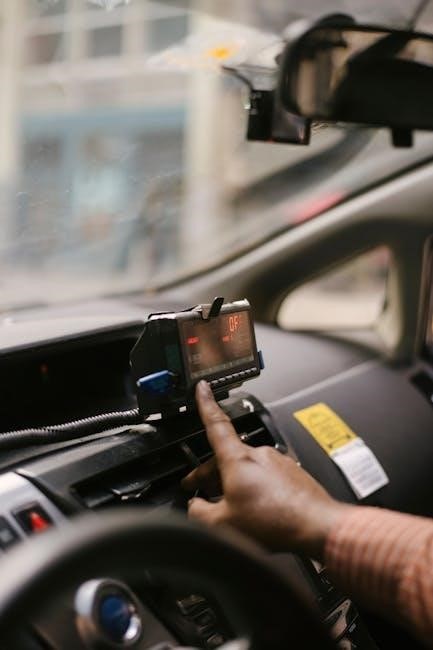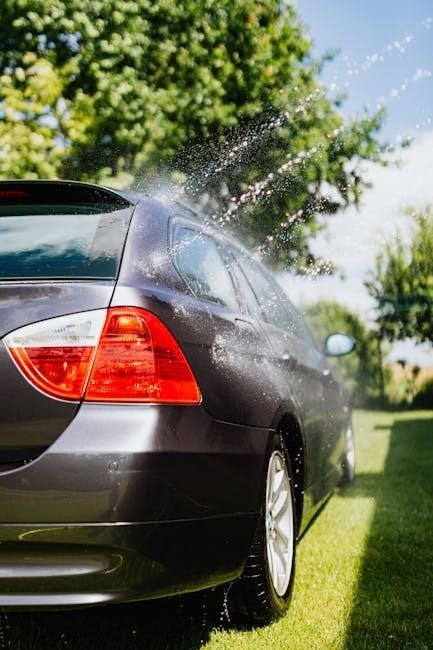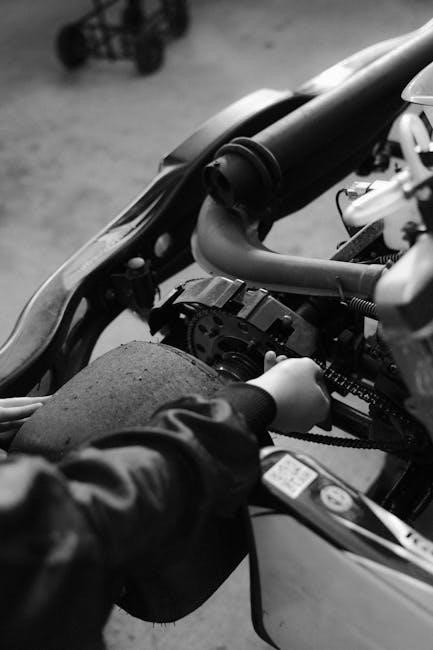
Welcome to the Vehicle Blackbox DVR User Manual! This guide provides comprehensive instructions for setup‚ operation‚ and troubleshooting your device. Discover key functions‚ technical specifications‚ and tips to maximize performance. Designed for both newcomers and experienced users‚ this manual ensures optimal use of your DVR.
1.1 Purpose of the Manual
This manual serves as a comprehensive guide to help users understand and effectively utilize their Vehicle Blackbox DVR. Its primary purpose is to provide clear instructions for setting up‚ operating‚ and troubleshooting the device. Whether you’re a new or experienced user‚ this manual ensures you maximize the DVR’s potential. It covers essential functions‚ technical details‚ and practical tips to enhance your experience. By following this guide‚ you’ll gain confidence in using the DVR’s features‚ resolving common issues‚ and maintaining optimal performance. Designed to be user-friendly‚ this manual is your go-to resource for all aspects of your Vehicle Blackbox DVR.
1.2 Structure of the Manual
This manual is organized into eight main sections to ensure easy navigation and comprehensive understanding of the Vehicle Blackbox DVR. Starting with an introduction‚ it progresses through features‚ installation‚ operation‚ troubleshooting‚ maintenance‚ advanced settings‚ and concludes with final tips. Each section is further divided into subheadings‚ providing detailed information on specific topics. The logical flow allows users to follow step-by-step instructions‚ access troubleshooting solutions‚ and explore customization options. Whether you’re installing the device or optimizing its performance‚ the manual’s structured approach ensures you can quickly find the information you need. This layout is designed to enhance user experience and simplify the learning process for all users.

Features and Specifications of the Vehicle Blackbox DVR
The Vehicle Blackbox DVR boasts Full HD 1080p resolution‚ dual-lens recording‚ night vision‚ and motion detection. It supports loop recording‚ storage expansion‚ and emergency recording for added safety.
2.1 Key Features of the Device
The Vehicle Blackbox DVR is equipped with Full HD 1080p resolution‚ ensuring high-quality video recording. It features a dual-lens design‚ capturing both front and rear views simultaneously. The device includes night vision‚ enhancing low-light recording‚ and motion detection‚ which automatically starts recording when motion is detected. It also supports loop recording‚ allowing continuous recording by overwriting old files. The DVR has an emergency recording feature that saves footage during sudden events. Additionally‚ it offers wireless connectivity for easy file transfer and smartphone app integration. These features make it a reliable and versatile dash cam for drivers seeking security and convenience.
2.2 Technical Specifications
The Vehicle Blackbox DVR boasts a 3-inch LCD screen for clear playback and menu navigation. It supports Full HD 1080p video resolution at 30fps‚ ensuring crisp and detailed recordings. The device is equipped with a 500mAh lithium-ion battery and supports microSD cards up to 256GB for ample storage. It features wireless connectivity for easy file transfer and app integration. The DVR operates on a 5V power supply and includes a built-in microphone for audio recording. It supports AVI and MP4 video formats and is compatible with multiple languages. Designed for durability‚ the device operates in temperatures ranging from -20°C to 60°C‚ making it suitable for various climates. These specifications ensure reliable performance and versatility for drivers.
2.3 Comparison with Other Models
The Vehicle Blackbox DVR stands out among similar devices with its compact design and user-friendly interface. Unlike many dash cams‚ it offers dual-lens functionality‚ capturing both front and rear views simultaneously. Its 1080p resolution surpasses lower-resolution models‚ providing clearer footage for evidence. While other models may lack wireless connectivity‚ this DVR supports Wi-Fi‚ enabling seamless file transfers. Battery life is another strong point‚ with a 500mAh capacity that outperforms many competitors. Additionally‚ its affordable price point makes it an excellent choice for budget-conscious drivers without compromising on quality. These features make it a top contender in the dash cam market‚ offering exceptional value for its price.

Installation and Setup of the Vehicle Blackbox DVR
Mount the DVR on your rearview mirror using the provided rubber mounts. Adjust the position for optimal view‚ insert the memory card‚ and connect the charger. Power on to complete setup.
3.1 Mounting the Device
Welcome to the mounting section of your Vehicle Blackbox DVR setup! Securely attach the DVR to your car’s rearview mirror using the provided rubber mounts. Ensure the device is level and tightly fastened for a clear view. For optimal placement‚ position the DVR near the windshield to capture the road ahead. Clean the mirror surface before mounting to ensure a strong grip. If preferred‚ you can also use the adhesive mount for a permanent installation. Tighten all screws firmly to prevent any movement while driving. Once mounted‚ adjust the angle to achieve the best recording perspective. Your DVR is now ready for use!
3.2 Connecting Cables and Accessories
Connect the car charger to the DVR and plug it into your vehicle’s 12V power outlet. Ensure the charger is securely fitted to avoid loose connections. If your model includes a rear camera‚ attach it to the DVR using the provided cable. Insert the memory card into the designated slot‚ ensuring it clicks into place. Connect any additional accessories‚ such as a USB cable for data transfer. Power on the device to verify all connections are functional. For proper operation‚ ensure all cables are tightly secured and routed neatly to avoid obstruction. This setup ensures seamless recording and optimal performance of your Vehicle Blackbox DVR.
3.3 Synchronizing with Rear Camera (if applicable)
To synchronize your Vehicle Blackbox DVR with a rear camera‚ first‚ connect the rear camera cable to the DVR’s designated port. Ensure both devices are powered on and the DVR is in standby mode. Navigate to the menu‚ select the “Rear Camera” option‚ and enable it. Adjust settings like camera angle and brightness for optimal clarity. Test the synchronization by playing back the rear camera feed to ensure proper connection. If issues arise‚ restart both devices and repeat the process. Proper synchronization ensures simultaneous recording from both cameras‚ enhancing your vehicle’s surveillance capabilities. This step is essential for dual-camera models to function effectively. Always refer to your specific model’s instructions for precise steps. Regularly check connections to maintain synchronization.

Operating the Vehicle Blackbox DVR
Power on the DVR using the designated button. Navigate the menu using the OK and R buttons for settings and playback. Start recording automatically or manually. Access emergency recording to capture critical moments instantly. Use the lock button to protect important files from overwrite.

4.1 Powering On and Off
To power on the Vehicle Blackbox DVR‚ press the POWER button. The device will automatically start recording when the car ignition is turned on. If the car is shut off‚ the DVR continues operating for 15 seconds before turning off and saving the last recording. For manual control‚ press the POWER button again to turn it off. Ensure the device is connected to a 5V car charger for proper operation. Avoid using unauthorized chargers to prevent damage. Always power off the DVR before disconnecting it from the power source to maintain functionality and data integrity. Proper power management ensures reliable performance and recording quality. Follow these steps for seamless operation.
4.2 Navigating the Menu System
The Vehicle Blackbox DVR features an intuitive menu system designed for easy navigation. To access the menu‚ press the MENU button. Use the R button to scroll through options and OK to select. The menu includes settings for video quality‚ timestamp‚ and motion detection. Adjust settings by navigating with the R button and confirming with OK. To exit‚ press MENU again. This system ensures quick access to features‚ enhancing user experience. Explore the menu to customize your DVR settings effectively and efficiently. Proper navigation ensures optimal device performance and personalized recording preferences. This user-friendly interface makes it easy to configure your DVR to meet your specific needs.
4.3 Recording and Playback Functions
Your Vehicle Blackbox DVR offers seamless recording and playback capabilities. Press the POWER button to start recording automatically. The device features loop recording‚ which overwrites old files when storage is full. For emergency situations‚ press the LOCK button to save crucial footage. To playback‚ navigate to the PLAYBACK menu using the R button and select files with OK. Videos can also be viewed on a computer via USB. The DVR supports time-lapse recording and video stabilization for smoother playback. Ensure your memory card is properly inserted for optimal performance. This feature-rich system allows you to capture and review your journeys effortlessly‚ enhancing your driving experience with reliable recording and clear playback options;
4.4 Using the Emergency Recording Feature
The emergency recording feature on your Vehicle Blackbox DVR is designed to capture critical moments. Press the LOCK or EMERGENCY button to activate it‚ saving the current recording and preventing it from being overwritten. This function is ideal for accidents or unexpected events. Ensure the device is powered on and a memory card is inserted for this feature to work. The DVR will automatically mark and protect the emergency file. Access these recordings in the PLAYBACK menu under a dedicated folder. Regularly check your settings to ensure emergency recording is enabled‚ providing peace of mind while driving. This feature is a vital tool for preserving important evidence‚ ensuring your safety and security on the road.

Troubleshooting Common Issues
Troubleshooting your Vehicle Blackbox DVR? Common issues include no power‚ no image‚ or rear camera malfunctions. Check power connections‚ format memory cards‚ and adjust settings for resolution.
5.1 Common Problems and Solutions
Experiencing issues with your Vehicle Blackbox DVR? Common problems include no power‚ no image on the screen‚ or rear camera malfunction. Solve these by checking power connections‚ ensuring the device is fully charged‚ and formatting memory cards. For no image‚ adjust the lens focus or reset the device. If the rear camera isn’t syncing‚ ensure proper cable connections and synchronization. Resetting the DVR to factory settings can often resolve software-related issues. Always refer to the manual for detailed troubleshooting steps and ensure firmware is up-to-date for optimal performance.
5.2 Resetting the Device
To reset your Vehicle Blackbox DVR‚ locate the reset button (usually found on the underside or rear of the device). Use a small pin or SIM card tool to press and hold the button for 5-10 seconds. The device will power off and restart‚ restoring factory settings. Note that resetting will erase all custom settings but will not delete recorded files. This process is useful for resolving software-related issues or starting fresh with default configurations. Ensure the device is powered on before attempting a reset. After resetting‚ refer to the manual to reconfigure your preferred settings for optimal performance.

5.3 Updating Firmware
To ensure your Vehicle Blackbox DVR performs optimally‚ regular firmware updates are essential. Visit the manufacturer’s website to download the latest firmware version. Save the update file to an empty memory card and insert it into the DVR. Navigate to the menu system‚ select Settings‚ and choose Firmware Update. Follow on-screen instructions to complete the process. Do not interrupt the update‚ as this may cause device malfunctions. Once updated‚ restart the device to apply changes. Regular updates improve functionality‚ add features‚ and fix bugs. Always use the official website to download updates to ensure compatibility and security.

Maintenance and Care
Regularly clean the DVR with a soft cloth to avoid dust buildup. Manage memory by deleting unnecessary files and ensure proper battery maintenance for optimal performance.
6.1 Cleaning the Device
Regular cleaning is essential to maintain your Vehicle Blackbox DVR’s performance. Use a soft‚ dry cloth to gently wipe the exterior and screen‚ removing dust and fingerprints. Avoid harsh chemicals or abrasive materials that may damage the surface. For tougher smudges‚ lightly dampen the cloth with water‚ but ensure no moisture enters the device. Never clean the DVR while it is powered on or connected to a power source. This simple maintenance routine will prevent dust buildup‚ ensure clear visibility‚ and prolong the lifespan of your device. Cleaning regularly is crucial for optimal functionality and video clarity.
6.2 Managing Memory and Storage
Proper memory and storage management ensures your Vehicle Blackbox DVR operates efficiently. Use a compatible SD card (recommended Class 10 or higher) and regularly check its storage capacity. When the card is full‚ enable loop recording to overwrite older files. Avoid using multiple small memory cards‚ as this can reduce performance. Always format the SD card in the device‚ not on a computer‚ to prevent formatting errors. To free up space‚ transfer important files to your computer or external storage before deleting them. For optimal functionality‚ update your firmware periodically and avoid overfilling the storage to maintain smooth recording and playback capabilities.
6.3 Battery Maintenance
To ensure optimal performance and longevity of your Vehicle Blackbox DVR’s battery‚ follow these guidelines. Always use the provided 5V car charger to avoid overcharging or damaging the battery. Store the device in a cool‚ dry place when not in use to prevent overheating‚ which can degrade battery health. Regularly check the battery level indicator on the device to monitor charge status. If the battery drains completely‚ allow it to charge fully before turning it on again. Avoid leaving the device unused for extended periods without charging‚ as this can cause deep discharge and reduce battery life. Proper maintenance ensures reliable operation and extends the lifespan of your DVR.

Advanced Settings and Customization
This section covers advanced customization options for your Vehicle Blackbox DVR‚ including video quality adjustments‚ time-lapse recording setup‚ and motion detection configuration to tailor the device to your needs.
7.1 Adjusting Video Quality Settings
Your Vehicle Blackbox DVR allows you to customize video quality for optimal clarity. Access the Settings menu and navigate to Video Quality. Choose between HD 1080p or lower resolutions to balance detail and storage. Adjust the bitrate for smoother video or sharper images. Select from pre-set options or manually fine-tune settings. Higher frame rates (e.g.‚ 60fps) enhance motion capture. Experiment with these settings to find the perfect balance for your needs. Remember to reboot the device after changes. For more details‚ refer to the manual or online guides for specific model instructions.
7.2 Setting Up Time Lapse Recording

To enable Time Lapse Recording on your Vehicle Blackbox DVR‚ navigate to the Advanced Settings menu. Select Recording Mode and choose Time Lapse. Set the desired interval (e.g.‚ 1 frame per second) to reduce storage usage. This feature is ideal for long-term monitoring. After configuring‚ press OK to save changes. The DVR will capture footage at the specified intervals‚ ensuring continuous recording without filling the memory card quickly. Note that longer intervals may reduce video smoothness. Always test the settings to ensure they meet your requirements. Refer to the manual for additional customization options to optimize your recording experience.
7.3 Configuring Motion Detection
To configure the motion detection feature on your Vehicle Blackbox DVR‚ go to the Advanced Settings menu and select Motion Detection Settings. Enable the feature and adjust the sensitivity levels (low‚ medium‚ or high) based on your preferences. The DVR will automatically start recording when motion is detected‚ ensuring capturing of important events. You can also set the duration of the recording after motion is detected. For added security‚ enable the G-sensor to activate recording during sudden movements or collisions. Test the settings to ensure proper functionality. This feature is ideal for 24/7 monitoring‚ providing peace of mind while your vehicle is unattended. Always check the device’s LED indicators to confirm motion detection is active.
8.1 Maximizing the Performance of Your DVR
To ensure your Vehicle Blackbox DVR operates at its best‚ always position the camera for an unobstructed view. Regularly update the firmware and clean the lens for clear footage. Use a high-quality memory card and avoid overfilling storage. Adjust settings like resolution and motion detection based on your needs. Keep the device charged and avoid extreme temperatures. For optimal night vision‚ ensure proper illumination. Finally‚ review recordings periodically to ensure everything is functioning correctly. By following these tips‚ you’ll enhance reliability‚ video quality‚ and overall performance‚ ensuring your DVR serves as a trusted companion on the road.
8.2 Staying Updated with the Latest Features
Regularly check for firmware updates to ensure your Vehicle Blackbox DVR has the latest features and improvements. Updates often enhance performance‚ add new functionalities‚ and fix issues. Visit the manufacturer’s website or use the device’s built-in update feature. Before updating‚ backup your data and follow the instructions carefully. New features may include improved night vision‚ enhanced motion detection‚ or expanded storage compatibility. Stay informed about software releases and user feedback to make the most of your DVR. By keeping your device updated‚ you ensure it remains reliable and continues to meet your evolving needs on the road.